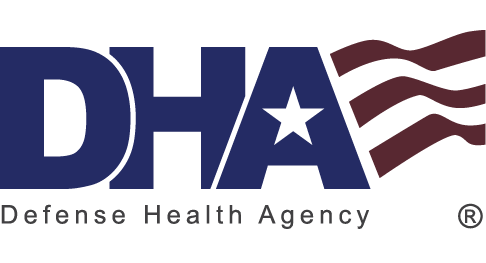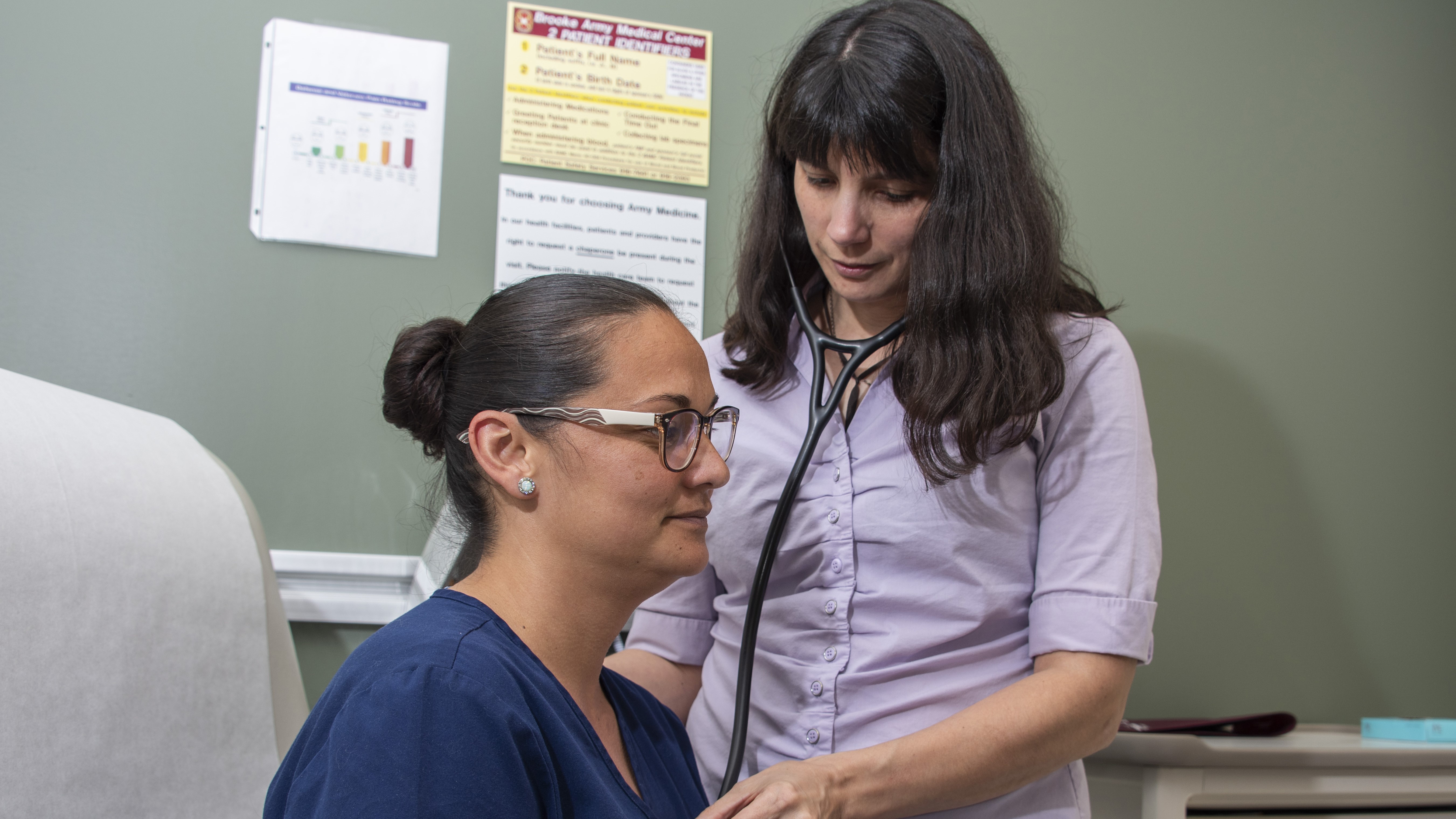April 28, 2025 | By Brandy Ostanik-Thornton, Medical Department Activity – Alaska
FORT WAINWRIGHT, Alaska — In a small treatment room inside Bassett Army Community Hospital, Joann Allison quietly breathes as golden needles are placed into her ear. She isn’t here for a routine exam; she’s undergoing a specialized treatment called Battlefield Acupuncture, or BFA. And for many patients at Medical Department Activity – Alaska, this emerging technique is delivering more than just pain relief, it's restoring sleep, improving mood, and helping service members get back in the fight.
Battlefield Acupuncture is a specific protocol developed in the early 2000s by Air Force physician Dr. Richard Niemtzow. Unlike traditional acupuncture, which utilizes hundreds of points across the body, BFA focuses on five targeted locations in the ear to disrupt pain signals and activate the body’s natural healing mechanisms. “Ear acupuncture and full-body acupuncture have been around for over 4,000 years,” said Maj. Melissa Perkins, a nurse practitioner at Bassett ACH who administers BFA to soldiers, family members and retirees at MEDDAC-AK. “There are more than 100 points on the ear alone, but this protocol focuses on the five that address how your brain and body process acute and chronic pain.”
From a Western medicine perspective, inserting needles at these five points stimulates the release of serotonin, dopamine, melatonin, and even the body’s natural opioids, said Perkins. These biochemicals are known to reduce inflammation, improve circulation, and modulate pain without the use of narcotics. From a traditional Chinese medicine perspective, the approach clears “qi” blockages, allowing energy to flow freely through the body. “In Chinese medicine, the body is a highway system,” Perkins explained. “If qi is blocked, it’s like a traffic jam that causes injury or illness. Acupuncture clears those jams, and the body repairs itself.”
The treatment is particularly appealing in military environments where cold temperatures, remote locations, and the physical demands of duty can leave soldiers vulnerable to pain or injury. In Alaska, those factors are amplified. “We're limited in what pain management we can provide up here,” Perkins said, “so when we can use something low-risk, low-cost, and field-adaptable to reduce pain, improve sleep, and support recovery, it’s a win for readiness.”
Needles on the Move
The “battlefield” aspect of BFA isn’t just branding, it refers to the portability and practicality of the protocol. The needles, or “semi-permanent needles,” are small enough to fit into a cargo pocket and can remain in the ear for several days. That’s particularly helpful in austere environments, where traditional pain medications may be unavailable or impractical.
“If we’re out in the Arctic, or on a mission, I can expose an ear, insert the points, cover it back up, and keep a soldier moving,” the provider said. “I’ve had people drop their pain level from an 8 to a 5, or from a 5 to a 2. This might be the difference between a soldier needing to be carried from the battlefield to being able to walk out on their own or with the help of a battle.”
Perkins has performed BFA over 700 times, with fewer than 15 patients who did not respond positively to the treatment. Responses range from warmth and tingling to a floating euphoria or significant relief in targeted pain areas. “It’s not uncommon to hear someone say, ‘It feels like a warm shower’ or ‘My headache is shrinking,’” she said. “I've had patients who hadn’t dreamt in years come back and tell me their sleep scores have hit 100%.”
Sleep, she emphasized, is where the body repairs itself, both physically and emotionally. “When someone sleep better, their mood stabilizes, their energy improves, and their resilience increases. That’s vital for mission success.”
Not Just on the Battlefield
While use on the battlefield is a definite plus, the protocol is also successfully used in the treatment room. After just one visit Allison noticed significant improvements in pain experienced due to migraines and endometriosis. “My jaw wasn’t as tight anymore,” says Allison. “It was able to relax without me constantly reminding myself to release it. When asked about her sleep after her last BFA session, she shared, “I actually slept through the night, which doesn’t happen for me.
Allison isn’t the only one who noticed a difference. “She was more focused and distracted by her pain these past couple of weeks,” said her husband, Stuart.
According to Perkins, the pain management without the use of pharmaceuticals is extremely important to patients like Allison, especially considering past surgeries and the side effects of certain medications on pregnancy, weight, and cognition.
A Non-Pharmacologic Bridge
The rising popularity of BFA coincides with the military's push for non-pharmacologic pain management solutions amid a national opioid crisis. In the early 2000s, military leadership recognized that a new approach was necessary. “In those days, everything was narcotics,” Perkins explained. “But pain is complex. We needed something more, something in between opioids and just Motrin and drink more water.”
Battlefield Acupuncture filled that gap. It was inexpensive, easy to teach, and effective enough to gain traction across military treatment facilities said Perkins. At MEDDAC-AK, it’s now one of several tools used to reduce dependency on medications and support faster recovery. “I always tell patients: this isn’t the only tool, and it’s not forever,” she said. “But if it can signal the brain that something different is happening, it complements movement therapy, physical therapy, even medications when necessary.”
Changing the Message in the Brain
One of the most profound effects of BFA may be its ability to “re-educate” the brain after long-term injury. Soldiers recovering from joint replacements, for example, often experience phantom pain because the brain remains on high alert even after the injury is resolved. “If I can use BFA to help their brain realize the pain is gone, then suddenly they move better in physical therapy, they get off profiles faster, and they recover more completely,” Perkins said. All of which helps ensure soldier readiness.
This effect isn’t just anecdotal, neuroscience supports it. In one study, functional MRIs showed reduced brain activity in pain centers after only two of the five points were applied. A placebo group also showed some change, but not to the same degree. “It’s not all in your head—but it does go through your brain,” said Perkins with a smile.
From Skepticism to Trust
As with any unconventional treatment, BFA can raise eyebrows, especially among more seasoned soldiers. “I’ve had salty senior NCOs and skeptical providers,” she said. “So I lean into it, I’ll say, ‘Want to try the voodoo I do?’ and then I back it up with science.”
What wins people over is the outcome. Soldiers often experience pain relief, improved sleep, and emotional balance after just one session. “When people say, ‘I’ve tried everything,’ I say, ‘I bet you haven’t.’ Then they try it, and when it works, it’s powerful,” she said. “That drives me to do more.”
So much so, that she became a certified instructor in the technique, training other Army medics, physicians, and even specialists like dentists and behavioral health providers in how to use the protocol. “It crosses medical disciplines and even cultural barriers,” she said. “Everyone experiences pain differently, and this gives us another way to meet them where they are.”
Patient-Centered, Readiness-Focused
From treating acute muscle spasms at sick call to supporting long-term recovery after surgery, BFA is becoming a go-to tool in MEDDAC-AK’s readiness arsenal. It’s quick, efficient, and most importantly, patient-approved.
But Perkins warns patients not to overdo it after treatment. “If your brain hasn’t trusted you for months, and now suddenly you feel great, don’t go lift furniture or run hills. Listen to your body.”
For a technique that’s thousands of years old and just a few decades young in military medicine, the impact is clear: Battlefield Acupuncture is reducing pain, boosting resilience, and keeping America’s Arctic warriors mission-ready - one needle at a time.






